If you have reached the point where you are considering soundproofing your ceiling, you should do so immediately because failing to do so will make your time in your apartment less enjoyable and you may wind up detesting your neighbor. But do you know how to soundproof a ceiling? We will tell you where to begin to give you the confidence you need.
What is Ceiling Soundproofing?
Since sound is a type of energy and sound waves can pass through solids, liquids, and air, soundproofing restricts the amount of sound that can enter or exit a space. Materials that are poor at transmitting sound waves are used in soundproofing.
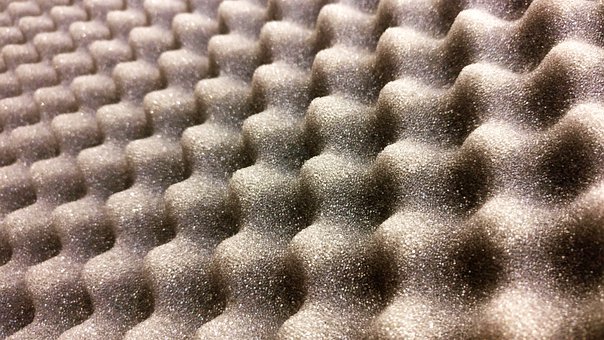
These materials have the ability to either block out undesired sounds or absorb sound waves. Ceiling soundproofing, for instance, involves treating the ceiling to stop sound from coming from the higher floor or to make it incapable of reflecting sound from the outside.
You will have to deal with certain kinds of noises when soundproofing.
Types of Noises
A source of noise, such as someone shouting upstairs for no apparent reason, can be generated or transmitted by collisions. Before you begin soundproofing, you must recognize these noises.
a) Airborne Noise
Airborne noise is troublesome because it will attempt to move between structural ceiling spaces that are a little more difficult to soundproof, and it may be originating from outside noises reflected by the ceiling. If your upstairs neighbors are partying all the time, you are experiencing airborne noise.
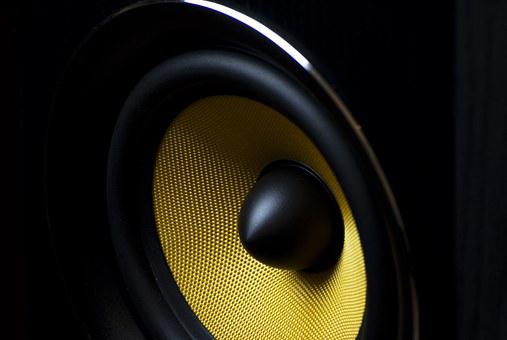
You must know how to soundproof a ceiling so that it will either scatter or absorb sound in order to block airborne sound. A surface that can absorb sound is just as excellent as one that is non-reflective.
The noise that originates from an exterior area, known as flanking noise, falls primarily under the category of airborne noise.
b) Impact Noise
The impact on the floor surface above your ceiling causes these sounds. You may remember the washing machine leaping up and down or children playing with balls upstairs. Perhaps your upstairs neighbors wear heels that make annoying noises when they leave early for work.

Solids transmit sound waves more quickly than water or air. Impact noise will therefore inevitably be louder than other types of noise. When an object strikes a structure—in this case, your ceiling—it creates structural noise.
How to Soundproof Your Ceiling
First, Plan
If you want to effectively block noise, you must be aware of the sort of ceiling you are working with. If you want to successfully eliminate the ceiling noise, you must take into account a number of variables before starting such a job. At least we've determined that we can't get rid of the noisy neighbors. What are the contributing components, then?
i) Where is the Noise Coming From?
You have to understand the type of noise you are dealing with and where it is coming from. For example, you are dealing with a different noise than your neighbors talking loudly if your neighbor is playing loud music with deep bass.
Given that both noises fall under the heading of airborne noise, why is this the case? The sound produced by a deep bass subwoofer is characterized by longer wavelengths, higher energy, and more destructive low frequencies. Have you ever wondered why your system vibrates when you add a bass? You are dealing with these waves.

The ear can hear within a certain frequency range. Dogs are able to detect a frequency that is too high for humans to hear. Dogs can hear up to 45 kHz, which is about twice as loud as humans, but humans can only hear at a level somewhat beyond 20 kHz. Cats can produce sounds you couldn't even conceive at frequencies above 60 kHz.
Pigeons can hear 0.5 Hz, but you have trouble hearing below 20 Hz. This implies that people will be aware of impending storms or earthquakes elsewhere.
What is the importance of this theory lesson? First, the fact that you can not hear a frequency does not mean it is not affecting you. For example, the military uses sonic weapons that produce loud (you will not hear them, but they are very intense) and low-frequency waves as a weapon. These noises can make you feel nauseated. This is proof that sound can harm you.
Point? Vibrations from fridges and other machines above can create discomfort without you knowing it. If you live close to a rail track or an airport, you will be dealing with low frequencies most of the time.
ii) Your Ceiling Type
After you've determined the source of the sound and its nature, it's time to identify the kind of ceiling that's hanging over you. This can help you determine what kind of soundproofing materials you'll need to address your noise issue.
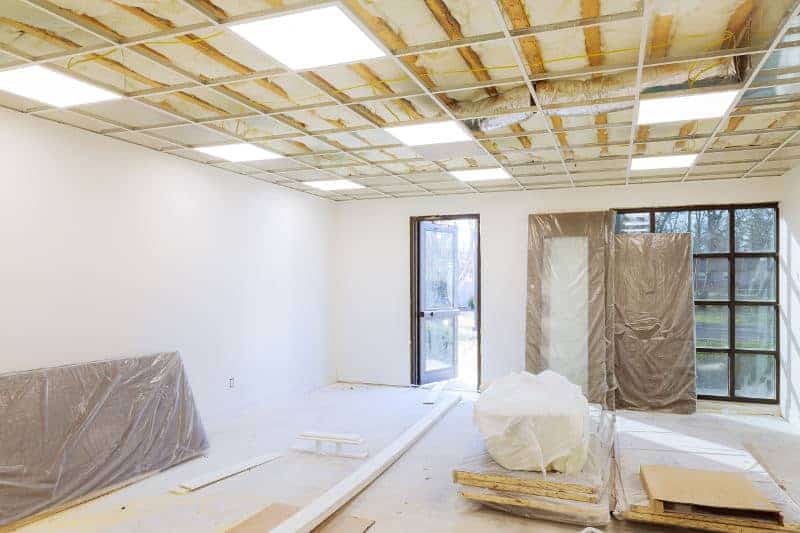
image source: soundproofliving.com
There are two types of ceilings.
- Drywall ceiling- These are ceilings consisting of gypsum plaster pressed between fiberglass and thick paper.
- Drop ceiling- A ceiling installed below an existing ceiling. Drop ceilings can be done for different reasons, including plumbing, cabling, and soundproofing.
Once you have ascertained the ceiling type you are dealing with, it might be a good time to pick the soundproofing you want.
iii) How Big is your Soundproofing Project?
Do you intend to soundproof all or a portion of the house? You don't need to soundproof the entire house, for instance, if the children's play area is located above your ceiling but only in one room. You can, however, if it fits within your budget.

You can do the soundproofing yourself, or you can hire a professional to do it. Both methods work and are easy to execute.
Modes of Soundproofing
There are a variety of general soundproofing techniques available. You should be able to accomplish one of the alternatives these modes offer you at your convenience. These are some ways to make your living area more tolerable.
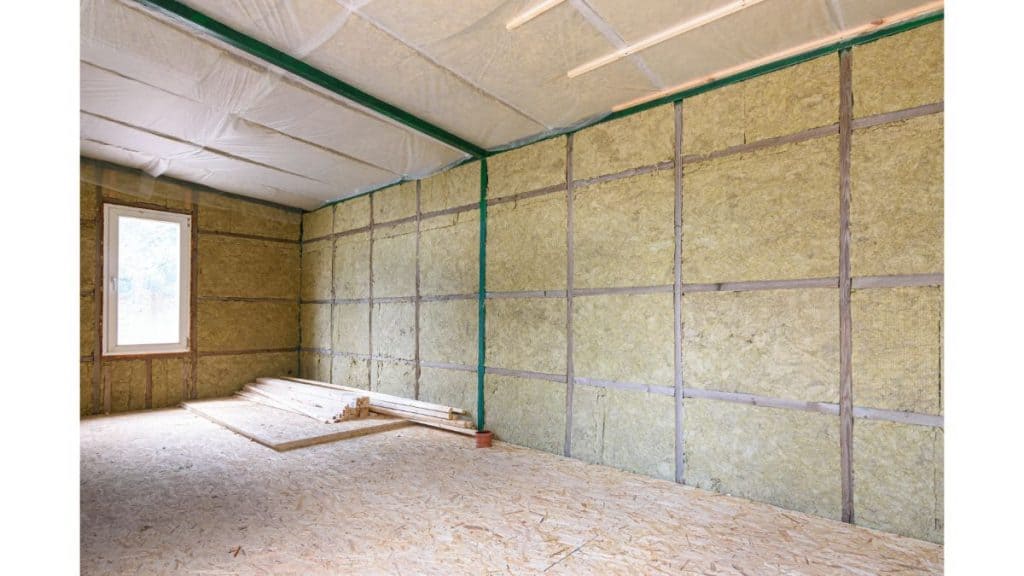
image source: soundproofingamerica.com
a) Absorption
Finding soundproofing techniques that absorb sound will result in the quietest rooms. Did you ever wonder why libraries are usually so quiet? Other from the need that users remain silent, the books absorb a lot of sound.
You can install absorptive materials to soundproof your space and get rid of any unwanted noise. Unfortunately, low-density materials make up the majority of these materials.
b) Decoupling
One practical soundproofing method that some people find effective is separating two layers. A generally effective sound barrier is produced by the distance between structures, particularly when structural noise is present. The decoupling method can be used to describe the soundproofing of dropped ceilings.
c) Damping
Sound waves are energy. Energy that flows through space is called a wave. It is crucial to address sound using this method as a result. Damping disperses sound waves and transforms them into thermal energy. It is pleasing to consider this.
d) Mass
The sound's ability to travel is hindered by the high mass. Therefore, compared to thin walls, thick walls will be more resilient to airborne noise. After hanging heavy curtains in your living room, have you ever noticed the difference they make?
When using materials that absorb sound, mass works this well.
How to Soundproof a Ceiling and How Much It Will Cost You
Here are a few tried-and-true strategies to keep your home peaceful and noise-free. This is Soundproofing 101. Welcome. How much will it cost to purchase soundproofing materials? Examine the prices shown below:
- Resilient Sound Isolation Clips-$5 - $10 per clip
- Mass loaded vinyl- $2.50-$5 per sq. ft.
- Acoustic Panels- $1 - $10 per sq. ft.
- Mass Loaded Vinyl- $2.50 - $5 per sq. ft.
- Green Glue- $15 - $30 per 28 oz.
- Insulation- $1.50 - $4 per sq. ft.
- Foam- $1.50 - $5 per sq. ft.
- Double Layer Drywall- $40 - $60 per sheet
1) The Floor Above
If your neighbor is sufficiently understanding, you can talk about putting barium sulfate and mass-loaded vinyl underneath the carpet. Furthermore, your neighbor can install thick, fashionable carpets. If there are children on the floor above or your neighbor like throwing parties, this will work out nicely for you. The fact that it addresses the issue at its root makes this one of the best soundproofing methods available.
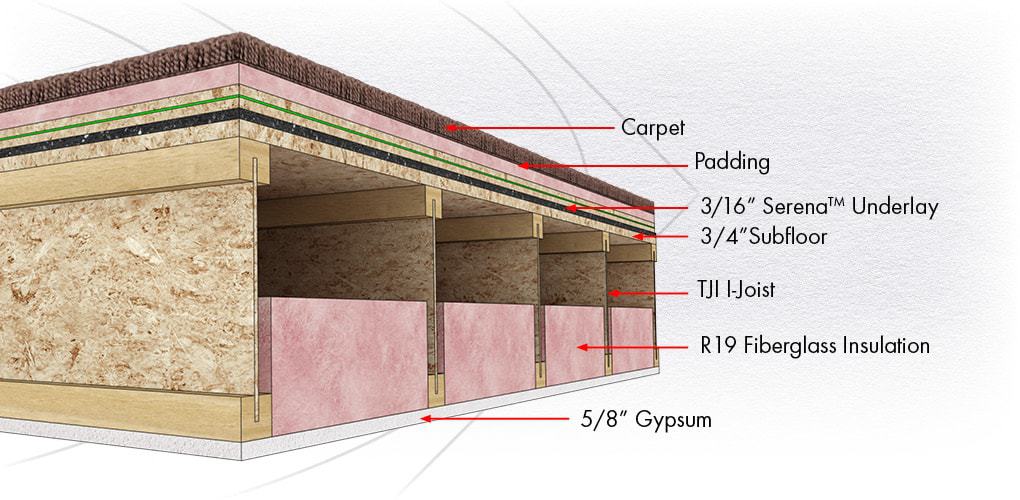
image source: SoundproofingCompany.com
Using underlayment vinyl soundproofing on the floor will eliminate the need to modify the existing ceilings. Most of the time, ceiling sensors, plumbing, and wiring should be left alone. Anytime you plan to alter the ceiling space, though, you must think about which systems you might be interfering with.
Your chances of successfully blocking out impact noises will increase if you can soundproof from the floor above.
2) Acoustic Foam Panels
Soundproof walls and the reduction of airborne noise are effectively achieved by acoustic foam panels. Most music studios utilize acoustic foam panels because they are excellent at reducing airborne noise.
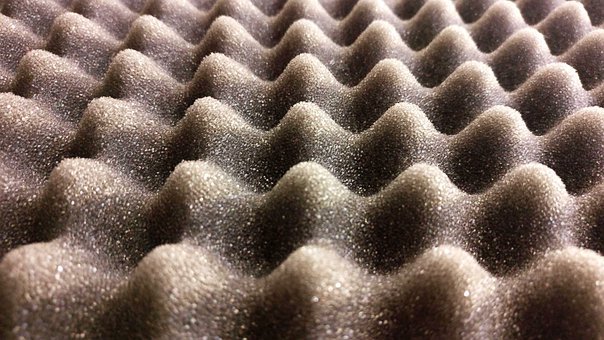
Compared to most soundproofing techniques, foam panels are less expensive and more readily available. The positioning of the foam panels in the room and your knowledge of how sound moves across a space will determine how soundproof they are.
3) Egg Panels
Do not remove the existing drywall ceiling if you have one. Egg panels can be used as an alternative to line the gaps between the ceiling. Egg trays behave in the same way as foam panels. Made of thick boards, the forms are excellent at absorbing the remainder of the sound and spreading it out.
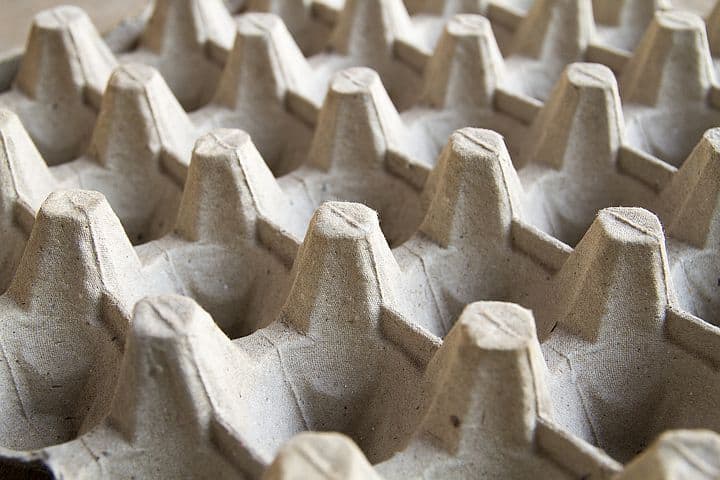
If you don't know how to style them, egg panels by themselves will look terrible. Although this soundproofing technique may not be as successful as others, it will provide you a soundproof ceiling to deter disputes upstairs.
4) Sound Interrupting Foil
It may surprise you to learn that aluminum foil is an excellent soundproofing material. Your home will be the quietest if you can figure out how to add layers of aluminum to your walls and ceiling without making it look unattractive. Aluminum is the greatest option for sound blocking because it doesn't absorb sound.

Gun ranges are among the locations that use aluminum. Your house's neighboring rooms have no chance. In addition to being excellent at reducing noise, aluminum is also reasonably priced and simple to work with. If you can add layers of metal around the areas you don't want sound to get through, you'll be set.
5) Acoustic Caulk
You may have soundproofing for your ceiling, but if you have gaps and holes, the ceiling soundproofing is as good as not having any. You want to seal any spaces and holes to prevent sound from leaking. Sound just has a way of finding its way, and you know it because some arguments are too spicy to miss out on.

image source: AQuietRefuge.com
The best material to use around light fixtures, openings, corners, and areas where the drywall ceilings may not be soundproof is acoustic caulk.
Acoustic caulk is a perfect complement to the other soundproofing techniques you will employ, so it should be the final thing you do after you have tried every other technique in your book. To make your finishes look nice and presentable, you can paint over the acoustic caulk. With this resource, you will have simultaneously solved two problems.
There is no use in spending a lot of money on ceiling soundproofing only to have sound leaking from small spaces and holes in the corners and fixation points on the ceiling.
6) Fiberglass Insulation
Before looking into more complex solutions, you can solve the noise problem by installing fiberglass. Fiberglass insulation is inexpensive and easily accessible.
Fiberglass comes in different forms, giving you options when installing ceiling soundproofing. You can get fiberglass ceiling tiles that you can install on the ceiling. The ceiling tiles are better than mineral fiber in keeping the room quiet and are more durable.
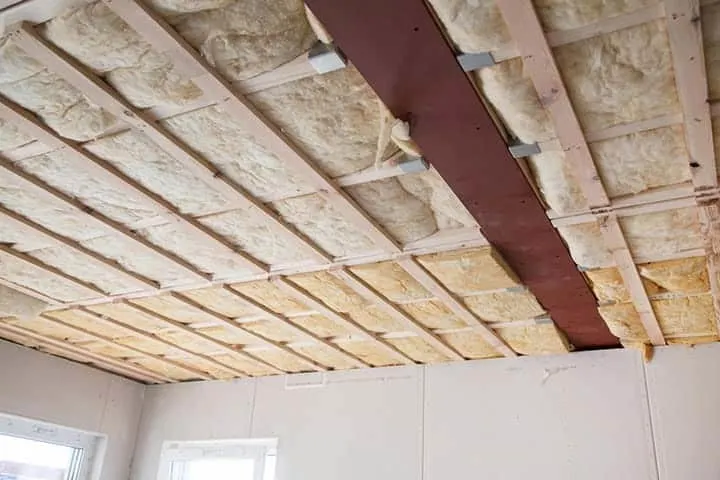
image source: soundproofcentral.com
While the mineral fiber performs a good job of blocking out noise, fiberglass ceiling tiles will not droop over time. To keep the spaces between tiles airtight, you may also use spray insulation everytime you use tiles.
7) Mineral Fiber
We have compared mineral fiber to fiberglass above. However, if mineral fiber is what you have available, you will successfully block sound transfer through the ceiling. You can get mineral fiber in the form of ceiling tiles and good ceiling noise attenuation, which the tiles are known for.
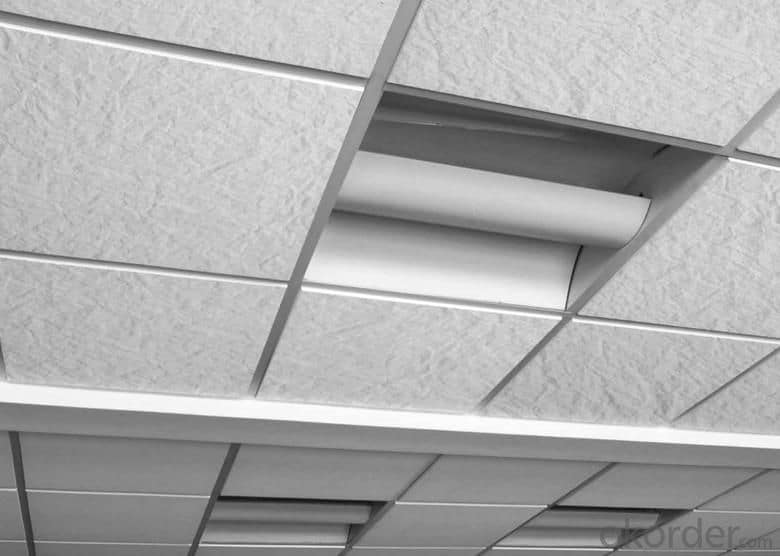
image source: Okorder.com
For suspended ceilings, both mineral fiber and fiberglass acoustic tiles perform admirably. Acoustic panels are adaptable for blocking out impact and airborne noise because they may be used for both drywall and suspended ceilings.
8) Drywall Ceilings
Drywall ceiling installations are a common preference that you will find on most ceilings. However, does this setup do a good job in reducing or cutting off the noise from upstairs? Drywall ceilings alone will not do a great job but will do just enough to keep the noise away. The ceiling should do fine if the noise is from a TV screen or conversations.
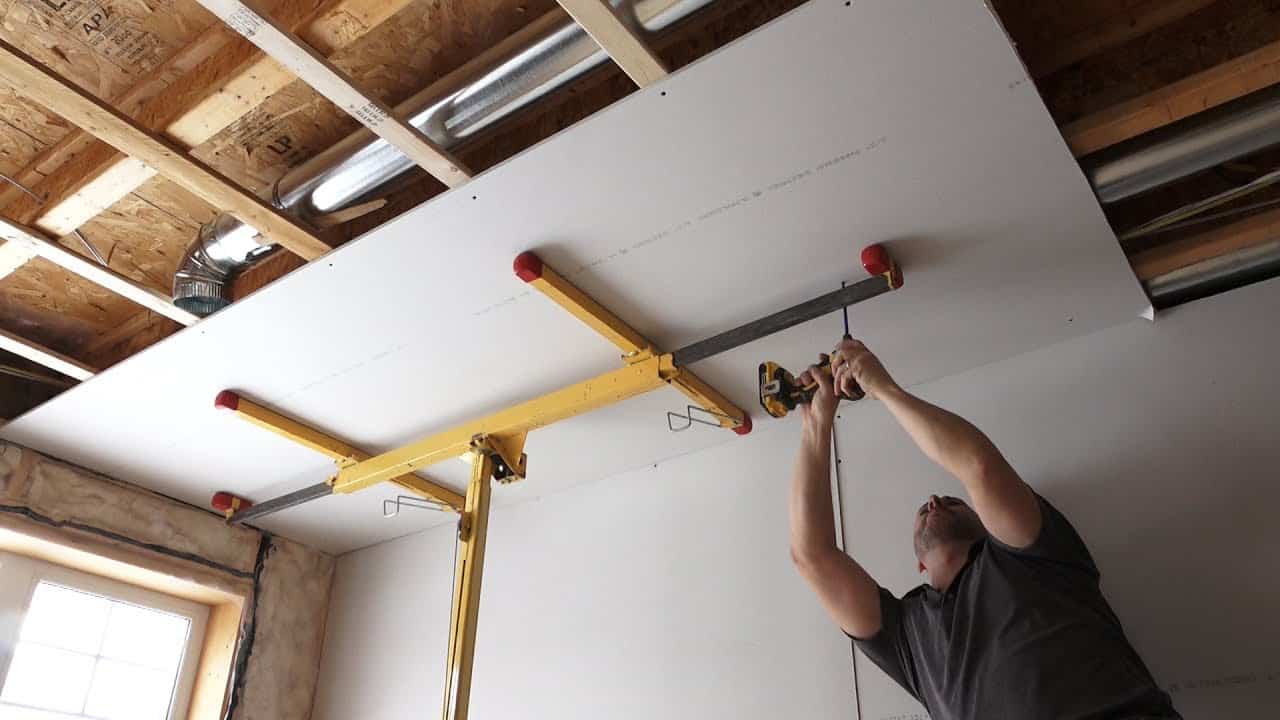
image source: constructionreviewonline.com
If done properly, drywall ceiling techniques can be costly yet effective. More chances for soundproof drywall can be created by using floating ceiling joists to generate a decoupling before drywall is installed.
9) Drywall and Fiberglass
While the existing ceiling drywall will only let in ambient sound, sometimes you want to keep all the sound out. For example, think of hosting a podcast in your house. The slightest noise will be a distraction. Therefore you can combine fiberglass with the drywall to create a solid soundproof solution to an existing ceiling.
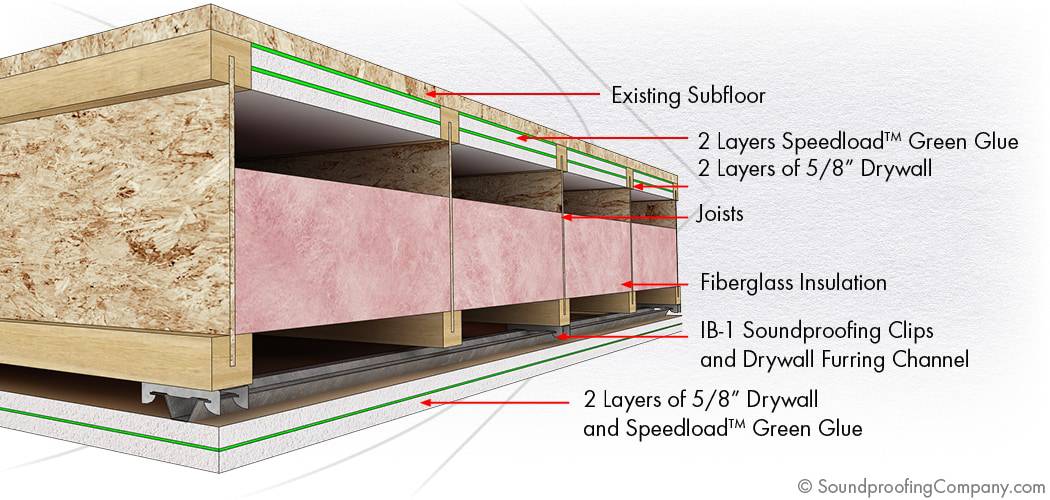
image source: SoundproofingCompany.com
To establish a robust decoupling with the floating ceiling joists, you might utilize soundproofing clips with hat channels. You can add a second layer of drywall by using these materials. Between these two layers, fiberglass is used to block off impact noise and airborne sounds.
10) Drywall and Green Glue Compound
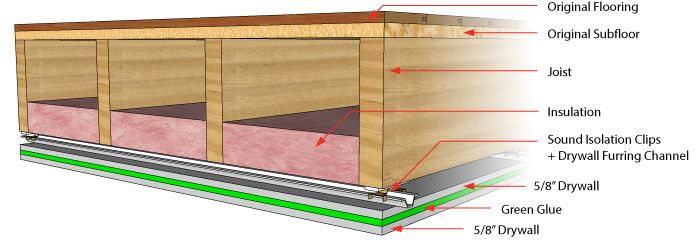
image source: pinterest.com
Green glue transforms impact noise and airborne sounds into kinetic energy. The noise is reduced to tolerable levels by this process. As a result, this green glue solution will work remarkably effectively to keep impact noise at bay. Impact noise is the most notorious of ceiling noises, and the remedy is to have one layer of drywall on top of another, lined with the adhesive in between.
Final Take
Soundproofing and yet being able to hear the noise from your above neighbors is sometimes more bothersome than the noise itself. Thus, it's ideal to do it correctly if you're thinking about soundproofing your ceiling. Combining the techniques is necessary to obtain airtight solutions. For instance, you can achieve good results by using a double layer of drywall with soundproofing underlayment.
To further lessen noise from upstairs and other areas of your apartment, you can use different combinations of soundproofing materials.














